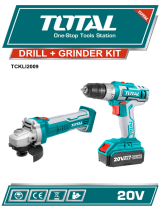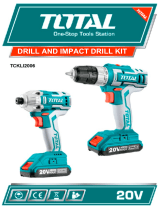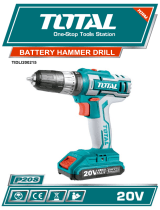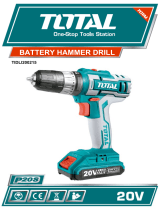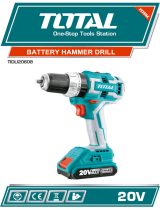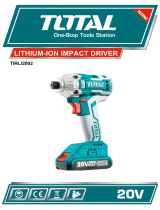Page is loading ...

1
v
LITHIUM-ION BATTERY DRILL
TDLI12325

2
Security instructions
Caution
Read all safety warnings and all instructions. Failure to follow the warnings and
instructions may result in electric shock, fire, and/or serious injury.
Note: Save all warnings and instructions for future reference.
1) Work area safety
a. Keep the work area clean and well lit to prevent accidents.
b. Do not use power tools in explosive atmospheres, such as in the presence
of flammable liquids, gases, or dust that can cause fires.
c. Keep children and other unauthorized persons away while using a power
tool. Distractions can cause you to lose control of the tool.
2) electrical safety
a. Power tool plugs must match the outlet. Never modify the plug in any way.
Using a suitable plug reduces the risk of electric shock.
b. Avoid bodily contact with grounded surfaces such as pipes, radiators,
ranges, and refrigerators. There is an increased risk of electric shock if
your body is grounded.
c. Do not expose power tools to rain or wet conditions. Water entering a
power tool will increase the risk of electrical shock.
d. Never use the cord to carry, pull or unplug the power tool. Keep the cable
away from heat or oil.
e. When using a power tool outdoors, use an extension cord suitable for
outdoor use.
f. If using the tool in a damp location is unavoidable, use a Residual Current
Device (RCD) protected supply to reduce the risk of electric shock.
3) Personal security
a. Always stay alert, watch what you are doing and use common sense
when using the tool.
b. Do not use a power tool if you are tired or under the influence of
medication or other substances.
c. Wear personal protective equipment. Always wear eye protection.
Protective equipment such as a dust mask, non-slip safety shoes, hard
hat, or hearing protection used in the proper conditions will reduce
personal injury. Also don't wear loose clothing or jewelry.
d. Prevent the tool from turning on unintentionally. Make sure the switch is
in the off position before connecting to power source and moving.
e. Remove any adjusting wrenches or wrenches before turning on the power
tool. An adjustable wrench or wrench placed in a rotating part of the power
tool can cause serious injury.
f. If devices are used for dust extraction and collection, make sure they are
properly connected. Properly use these devices and you will reduce dust-
related hazards.
4) Use and care of battery tools
a. Recharge the battery only with the charger specified by the
manufacturer. An unsuitable charger can create a fire hazard.

3
b. Use power tools only with specifically designated batteries. Use of other
batteries may create a risk of injury or fire.
c. When the batteries are not in use, keep it away from other metal objects,
such as paper clips, coins, keys, nails, screws, or other small metal
objects, that can make a connection from one terminal to another.
Shorting the battery terminals can cause burns or fire.
d. Abusive conditions can cause expulsion of liquid from the battery; avoid
contact. If accidentally contacted, rinse immediately with water. If the
liquid comes into contact with the eyes, also seek medical help. Liquid
expelled from the battery can cause irritation or burns.
e. Do not use a battery or tool that is damaged or modified. They may
exhibit unpredictable behavior resulting in fire, explosion, or risk of injury.
f. Do not expose a battery or tool to fire or excessive heat. Exposure to fire
or temperature above 130°C may cause an explosion.
g. Follow all charging instructions. Do not charge the battery or tool outside
the temperature range specified in the instructions. Improper charging
or charging at temperatures outside the specified range may damage
the battery or increase the risk of fire.
5) Service
a. Have your power tool serviced by a qualified person and use replacement
parts recommended by the manufacturer. This will ensure that the safety
of the power tool is maintained.
b. Never use damaged batteries. Battery packs should only be serviced by
the manufacturer or authorized service providers.

4
Safety rules for correct use
Double insulation for additional protection
Please read the instruction manual before use.
CE conformity.
Wear safety glasses, hearing protection and a dust mask.
Waste electrical products must not be disposed of with household
waste. Please recycle at the appropriate facilities. Check with your
local authority or retailer for recycling advice.
Security alert. Use only accessories supported by the manufacturer.
Charge the battery only below 40ºC
Always recycle batteries
Do not expose the battery to fire or high temperatures
Do not expose battery to water

5
Additional security warnings
Drill Safety Warnings
• Hold power tool by insulated gripping surfaces when performing an operation
where the cutting accessory may contact hidden wiring.
• The cutting accessory coming in contact with a "live" wire can make exposed
metal parts of the power tool "live" and could give the operator an electric shock.
Other risks
Even when the power tool is used as prescribed, it is not possible to eliminate all residual
risk factors:
a. Health defects resulting from vibration emission if the power tool is used for a
longer period of time or if it is not managed and maintained properly.
b. Injuries and property damage due to broken fixtures breaking suddenly.
Caution
This power tool produces an electromagnetic field during operation.
This field can, in some circumstances, interfere with active or passive
medical implants.
To reduce the risk of serious injury, we recommend that persons with
medical implants consult their physician before using this power tool.
The machine must not be damp and must not be used in a humid environment.
Attention
Safe operation of this machine is only possible when the operating or safety
information is fully read and the instructions contained therein are strictly
followed.
Technical data
TDLI12325 Data Sheet
Voltage
12V
Loading time
≅ 2h
Speeds
two
No load speed
0-350/0-1350 /min
Torque settings
15+1
Maximum torque
20Nm
Keyless chuck capacity
0.8—10mm

6
Product description
Attention
Always make sure the tool is turned off and the battery cartridge is removed before
adjusting or checking the function of the tool.
Installing or removing the battery cartridge
• Always turn off the tool before installing or removing the battery.
• To remove the battery cartridge, pull it out of the tool while sliding the button on
the front of the cartridge.
• To insert the battery cartridge, align the tab on the battery cartridge with the slot
in the casing and slide it into place. Always insert it all the way in until it clicks into
place with a small click.
• Do not use force when inserting the battery cartridge. If the cartridge does not
slide in easily, it is not being inserted correctly.
Exchange action
Caution
Before inserting the battery cartridge into the tool, always check that the switch trigger
actuates properly and returns to the "OFF" position when released.
• To start the tool, simply pull the switch trigger.
• Tool speed is increased by increasing pressure on the switch trigger.
• Release the switch trigger to stop.
1. Button
2. Battery cartridge
1. Trigger

7
Illuminating the front light
Caution
Do not look into the light or see the light source directly. Pull the switch trigger to turn on
the light. This light remains on while the switch trigger is pulled.
Note: Please use a dry cloth to clean the dirt on the lens of the light. Be careful not to scratch the
lens from the light, as this may decrease illumination.
Reverse switch action
This tool has a reverse switch to change the direction of rotation.
• Press the reversing switch lever from side A to rotate clockwise
• Do it from side B to turn counterclockwise.
• When the reverse switch lever is in the neutral position, the switch trigger cannot
be pulled.
Caution
• Always check the direction of rotation before operation.
• Use the reverse switch only after the tool has come to a complete stop. Changing
the direction of rotation before the tool stops can damage the tool.
• When not using the tool, always place the reversing switch lever in the neutral
position.
1. Trigger
1. switch lever
backup

8
Fast change
To change the speed:
• First turn off the tool
• Then slide the gear shift lever:
o Towards the "H" side for high speed
o Towards the "L" side for low speed
Make sure the gear shift lever is in the correct position before operation. Use the speed
that is right for your job.
Attention
• Always put the gear shift lever fully in the correct position. If you operate the tool
with the speed change lever positioned midway between side "1" and side "2",
the tool may be damaged.
• Do not use the speed change lever while the tool is running. The tool may be
damaged.
Tightening torque setting
The tightening torque can be adjusted in 18 steps by turning the adjusting ring so that its
graduations are aligned with the pointer on the tool body. The tightening torque is
minimum when the number 1 is aligned with the pointer and maximum when the mark
is aligned with the pointer.
The clutch will slip at various torque levels when set to number 1 to 18. The clutch is
designed not to slip at the mark.
1. Gear shift lever
1. Adjustment thread
2. Graduation
3. Pointer

9
Prior to actual operation, drive a test screw into your material or a piece of duplicate
material to determine what level of torque is required for a particular application.
Set up
Mounting
Caution
Always make sure the tool is switched off and the battery cartridge is removed before
carrying out any work on the tool.
Installing or removing a screwdriver bit or drill bit
• Turn the sleeve counterclockwise to open the chuck jaws.
• Put the bit into the chuck as far as it will go.
• Turn the sleeve clockwise to tighten the chuck.
• To remove the bit, turn the sleeve counterclockwise.
Start up
Caution
Always insert the battery cartridge all the way in until it clicks into place. Otherwise, it
may accidentally fall off the tool and injure you or someone around you.
Hold the tool firmly with one hand on the handle and the other hand on the bottom of the
battery cartridge to control the twisting action.
1. Chuck nut

10
Screwing operation
• Place the tip of the bit on the screw head and apply
pressure to the tool.
• Start the tool slowly and then gradually increase the
speed.
• Release the switch trigger as soon as the clutch
engages.
Caution
Set the adjusting ring to the proper torque level for your
job.
Make sure the screwdriver bit is inserted straight into the screw
head, or the screw and/or bit may be damaged.
When driving wood screws, pre-drill pilot holes to make driving
easier and prevent workpiece splitting.
Nominal diameter
of wood screw
(mm)
Recommended
Pilot Hole Size
(mm)
3.1
2.0-2.2
3.5
2.2-2.5
3.8
2.5-2.8
4.5
2.9-3.2
4.8
3.1-3.4
5.1
3.3-3.6
5.5
3.7-3.9
5.8
4.0-4.2
6.1
4.2-4.4
Drilling operation
First, turn the adjusting ring so that the pointer points to the mark . Then proceed as
follows.
Drilling in wood
When drilling in wood, the best results are obtained with wood drills equipped with a
guide screw. The guide screw facilitates drilling by driving the bit into the workpiece.
Metal drilling
To prevent the bit from slipping when starting a hole, make a notch with a punch and
hammer at the point to be drilled. Place the tip of the drill bit in the notch and start drilling.
Use a cutting lubricant when drilling metal. The exceptions are iron and brass, which
must be drilled dry.
Caution
Excessive pressure on the tool will not speed up the drilling. In fact, this excessive
pressure will only serve to damage the tip of your bit, decrease tool performance, and
shorten tool life.
Tremendous force is exerted on the tool/drill at the moment of hole breaking. Hold the
tool steady and be careful when the bit starts to go through the workpiece.

11
A stuck bit can be removed by simply placing the reversing switch in reverse rotation to
back out. However, the tool can snap back if you do not hold it firmly.
• Always secure small workpieces in a vise or similar holding device.
• If the tool is used continuously until the battery cartridge is discharged, let the tool
rest for 15 minutes before continuing with a new battery.
Maintenance
Caution
Always make sure the tool is turned off and the battery cartridge is removed before
attempting any inspection or maintenance.
Never use gasoline, thinner, alcohol or the like. May result in discoloration, warping, or
cracking.
To maintain the safety and reliability of the product, repairs or any other maintenance or
adjustments must be performed by authorized Service centers.
Accessories
Attention
These accessories are recommended for use with the tool specified in this manual. The
use of any other accessory may present a risk of injury to persons and even to the tool.
Only use the accessory for its intended purpose.
• Drill bits
• screw bits
• socket bits
• Batteries and chargers TOTAL
• Plastic carrying case
If you need help to get more details about these accessories, please consult your local
service center.
Environment
• Do not dispose of electrical appliances as unsorted municipal waste, use
separate collection facilities.
• Contact your local authority for information on available collection systems.
• If electrical appliances are disposed of in landfills, hazardous substances can
seep into the groundwater and enter the food chain, harming your health and
well-being.
• Recycle raw materials instead of disposing of them as waste.
• The machine, accessories and packaging must be sorted for environmentally
friendly recycling.
• Plastic components are labeled for categorized recycling.

12
Exploded view

13
LITHIUM-ION BATTERY DRILL
/
